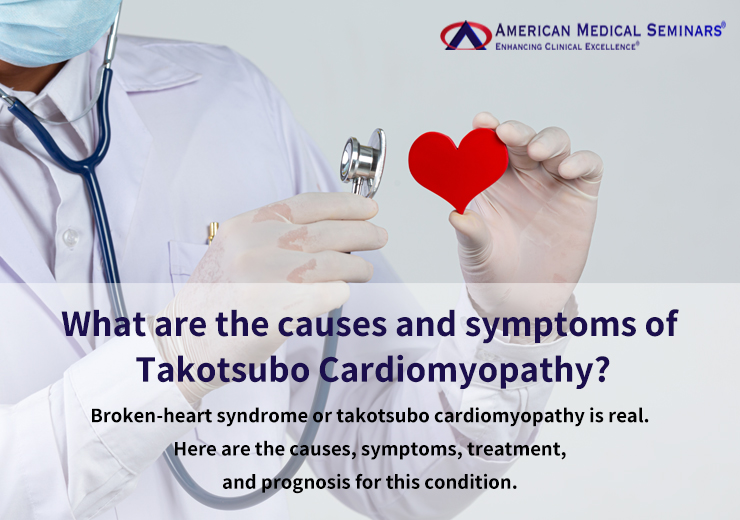
The scope of emergency medicine extends throughout the breadth of medicine and surgery and offers physicians insight into various sicknesses and ailments. One such ailment is the broken-heart syndrome which – as dramatic as it sounds – is an actual medical condition medically known as takotsubo cardiomyopathy. Here is a look at the causes of this temporary heart condition and symptoms patients might present.
What is takotsubo cardiomyopathy?
Takotsubo cardiomyopathy (first described in Japan in 1990) is a temporary heart condition with all the heart attack symptoms (myocardial infarction). However, on percutaneous coronary intervention (PCI) or heart catheterization, there is no angiographic evidence of blockage, acute plaque rupture, or coronary artery disease.
Takotsubo cardiomyopathy is the weakening of the left ventricle (LV), the heart’s main pumping chamber. The left ventricle balloons up (which also gives the name apical ballooning syndrome) and changes shape. It looks similar to a Japanese octopus trap – a Tako-Tsubo pot – used to catch octopus. The pot is a round-bottomed, narrow-necked pot, and that is where the condition gets its name. The change in the shape of the left ventricle affects the heart’s ability to continue to pump blood effectively.
The pathogenesis of takotsubo cardiomyopathy
The pathogenesis of takotsubo cardiomyopathy is still quite unclear. It is associated with intense emotional/physical stress, which causes a surge in stress hormones (epinephrine, norepinephrine, adrenaline, and dopamine). That, in turn, might cause diffuse catecholamine-induced microvascular spasms that stun/freeze the heart. When this happens, there are changes in coronary blood vessels or heart muscle cells (or both) that prevent the left ventricle from contracting correctly, and the heart cannot pump blood.
Takotsubo cardiomyopathy is often induced by stress, and so it is also referred to as stress-induced cardiomyopathy. Extreme sadness can cause this condition, so it is also referred to as a broken-heart syndrome. Emotional triggers that can lead to takotsubo cardiomyopathy include events like:
- A death in the family
- An unexpected and devastating medical diagnosis
- Natural disasters
- Domestic abuse
- Relationship conflict
- A fierce argument
- Financial loss
Physical stressors, too, can cause this condition. Physical stressors include:
- Car or other accident
- Exhausting physical effort
- surgery
- Intense fear
- Asthma attack
- Severe pain
- A sudden drop in blood pressure
Even positive stressful events like winning a lottery or a surprise birthday party have been known to cause takotsubo cardiomyopathy.
While takotsubo cardiomyopathy can occur in men and women at any age, it affects older women more – especially after menopause. A drop in estrogen activity might be a contributing factor.
Specific pathophysiological and clinical presentations in emergency medicine
Takotsubo cardiomyopathy starts abruptly and without warning. Patients most commonly present to the emergency room with symptoms similar to a heart attack. Here are some of the standard clinical presentations of takotsubo cardiomyopathy that physicians working in emergency medicine come across:
- Sudden and acute chest pain after a particularly stressful event
- Shortness of breath or sudden trouble breathing
- Fainting or syncope
- Hypotension
- Arrhythmia
Tests to diagnose Takotsubo cardiomyopathy
The following tests can be performed to rule out a heart attack and determine the cause of symptoms:
ECG
– takotsubo cardiomyopathy and myocardial infarction both show similar abnormalities – in particular, ST-segment elevation. Further tests and imaging studies will be required to rule out myocardial infarction.
Blood test
– to look for enzymes that might indicate damage to the heart muscle.
Echocardiogram
– an ultrasound of the heart can detect abnormal movements of the left ventricle.
Coronary angiogram
– to check the blood flow through the coronary arteries.
Definitive Diagnosis
Definitive Diagnosis of takotsubo cardiomyopathy include the following:
1. An angiogram shows no evidence of a block in the coronary arteries. In the case of a heart attack, blocks are prevalent.
2. There is a rapid but slight rise in cardiac biomarkers. The cardiac biomarkers take much longer to rise in the case of a heart attack, but they peak higher.
3. An echocardiogram shows abnormal movements in the left ventricle wall. Plus, there is a prominent ballooning of the apex (lower part) of the left ventricle. The ballooning resembles a tako-tsubo pot during systole (contraction).
Treatment
There is no definite treatment for takotsubo cardiomyopathy. Physicians recommend standard heart failure medications such as:
- Beta-blockers
- Combination of alpha and beta-blockers
- ACE inhibitors
- Diuretics
- Anticoagulants might be prescribed to avoid a stroke
- Aspirin (for patients with atherosclerosis)
- Anti-anxiety drugs
- Stress management
- Cardiac rehabilitation
Given that the condition is brought on by acute emotional stress, it is critical to alleviate any emotional or physical stress that might have played a role in triggering the attack.
Complications
Complications are rare but not impossible. Some complications that can arise from takotsubo cardiomyopathy include:
- Arrhythmias
- Heart failure
- Blood clots
- Heart valve problems
- Cardiogenic shock
- Rupture of the ventricle wall
- Blood flow obstruction (from the left ventricle).
Prognosis
Death is rare, and patients can fully recover within a few weeks to a few months. Any abnormality in the systolic function is set right in about four weeks, and patients can fully recover in about two months. About 20% of patients do experience heart failure.
American Medical Seminars is a leading creator of customizable, relevant, and evidence-based CME activities and courses designed to enhance clinical excellence and improve physician competence and patient care.
